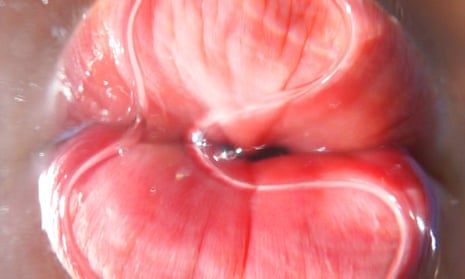Pipilotti Rist, London
Pipilotti Rist’s first major UK outing since 2011 promises more of the Swiss artist’s kookily sensual version of Shangri-La, with her immersive video art installations merging pleasures of the flesh with belly laughs. Visitors are invited to leave their cares at the door, lie back on plush carpet and relax watching peachy stretching skin and eyeballs; or (from 29 Nov to 22 Feb at Hauser & Wirth Somerset in Bruton) sexually suggestive stamen.
Hauser & Wirth, W1, Thu to 10 Jan
SS
Gavin Turk, nr Salisbury
Light sculpture tends to conjure to mind something conceptually hard-headed and aesthetically cool: minimalist fluorescent tubes or opaque phrases written in white light. Gavin Turk’s neon work, however, has all the attention-hungry dazzle of the Las Vegas strip. In this show of his neons from 1995 to 2013, the imagery tricked out in light runs the gamut of 20th-century art and pop. There’s a glowing yellow banana, like the one Warhol created for the Velvet Underground’s first album sleeve, an open door, and a red Maltese cross. The glow of these icons of culture and consumerism speaks of old ideas about art’s special aura and the lure of consumer baubles.
New Art Centre, East Winterslow, to 8 Feb
SS
Louisa Martin, Sheffield
Louisa Martin’s hypnotic installation The Lighthouse entices us in to what could be perilous psychological waters. A series of short video projections capture a lone female figure trying on different costumes and prosthetics in order to intimate a changing cast of personas. The protagonist, aided by lip-synching, dolled-up body doubles, isn’t always quite herself. Each film fragment evokes the travails of a make-believe personality who appears to be undergoing some kind of identity crisis, with the projected medium inevitably becoming a metaphor for psychic transference. Until, of course, it is turned off and the whole show and shadow-play disappears into the prevailing darkness of thin air.
Bloc Projects, to 20 Dec
RC
Caragh Thuring, London
London-based artist Caragh Thuring has been indulging in some suburban voyeurism for her latest paintings depicting the windows of Dutch homes, where pot plants nestle and bold, patterned curtains hang. Thuring sees these semi-public displays of domestic decor as self-portraiture of sorts, with the window’s four sides echoing those of the canvas. Disorienting reflections in the glass and loose scribbly brushstrokes suggest a confusion of interior and exterior space, public and private life. In other works, where the names of ancient London churches are daubed in a red script (work pictured), those indefatigable buildings hunkering between skyscrapers suggest the tension between the fixed image of a painting and the flux of interpretation.
Chisenhale Gallery, E3, Thu to 1 Feb
SS
Playtime, Manchester
The title of the Cornerhouse’s final show before it reopens as HOME in 2015 is taken from Jacques Tati’s 1967 film, in which tourists wander around an enormous illusionistic version of Paris. Here, nine artists have been invited to toast the gallery’s passing in a comparable spirit. Gabriel Lester’s Slap Door Crash Course tempts visitors into the gallery maze through a series of swing-door traps. Elsewhere, pedestrians will be directed to perform like fairground automata, and the Fall’s Mark E Smith can be heard reciting apparent banalities in his inimitable drawl.
Cornerhouse, Sat to 15 Mar
RC
Joan Fontcuberta, Bradford
Catalan photo artist Joan Fontcuberta’s exhibition Stranger Than Fiction plays with a presumption that one might think outmoded in our age of digitally manipulated realities – that the camera never lies. Fontcuberta (whose name translates enticingly as “hidden fountain”) charms us into believing what we see in his meticulously composed documentations, which include photographic evidence of mermaid fossils, levitating monks and four-legged baboons. Living under the propagandised realities of the Franco regime, the artist came to the conclusion that photography “is not an innocent medium”. And, for all our incredulity, he takes us in as we gaze at the God-given constellations of a starry sky, only to be told it’s all just dust captured on a windscreen. Indeed, this is Fontcuberta’s charm: he allows us to wonder at the unknown, despite it being exposed as virtually unbelievable.
National Media Museum, to 5 Feb
RC
Mark Neville, London
Mark Neville takes a social sweep worthy of Dickens in two complementary photographic series chronicling the haves and have-nots of London and Pittsburgh. The former includes grubby faced Tottenham urchins, the poised prize-fighters buying and selling on London’s metal exchange, and young toffs on the dancefloor of a Kensington club. This last image, where a woman in a dark red dress pouts towards the camera surrounded by suited white dancers, strikes a direct chord with one of the black revellers at a Pittsburgh nightspot. In the States, Neville has documented two neighbourhoods divided by race and cash, Braddock and Sewickley, one the beneficiary of the once-booming local steel industry, the other the victim of its implosion. Rather than images of destitution, however, he captures this split society at play. Photos of prom queens in satin skirts or party animals depict both racial segregation and cultural similarity.
Alan Cristea Gallery, W1, to 24 Jan
SS
Irma Blank, Amalia Pica, Llandudno
Irma Blank is an artist who speaks in primordial signs and sounds, abstract calligraphies and concrete poems that might be practically indecipherable, yet, by this very token, can hint at something like the unspeakable. Her work is paired here with that of Amalia Pica. Growing up in Argentina during the post-Perón years, Pica has a penchant for eavesdropping contraptions and spotlights that put you on the spot. Her mixture of photography, sculpture and drawing can come on like tableaux in which each separate piece plays a conversational part. Recognising the essential gulf of communication that prevents complete empathy, she conveys a sense of the dizziness of the divide.
MOSTYN, to 1 Mar
RC

Comments (…)
Sign in or create your Guardian account to join the discussion